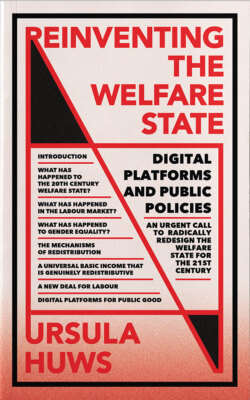Reinventing the Welfare State

Реклама. ООО «ЛитРес», ИНН: 7719571260.
Оглавление
Ursula Huws. Reinventing the Welfare State
Reinventing the Welfare State
Contents
Series Preface
Preface
Acknowledgements
CHAPTER ONE. Introduction
CHAPTER TWO. What Has Happened to the Twentieth-century Welfare State?
THE MID-TWENTIETH-CENTURY WELFARE STATE: A CLUSTER OF CONTRADICTIONS
POST-WAR CIRCUMSTANCES FORGED UNUSUAL SOLIDARITIES
A REVERSAL IN THE DIRECTION OF REDISTRIBUTION
A TWENTY-FIRST CENTURY WORKHOUSE WITHOUT WALLS
THE GLOBAL DIVISION OF LABOUR HAS FRACTURED SOLIDARITIES BETWEEN ORGANISED WORKERS AND THE ‘RESERVE ARMY’
DEMONISATION OF ‘SCROUNGERS’, IMMIGRANTS AND OVERSEAS WORKERS
BLAMING THE BABY BOOMERS
GENERATION SET AGAINST GENERATION
CONCLUSION
CHAPTER THREE. What Has Happened in the Labour Market?
THE STANDARD EMPLOYMENT MODEL WAS ALWAYS INCOMPLETE
EROSION OF THE STANDARD MODEL
THE EMERGENCE OF THE ONLINE PLATFORM
A GENERAL ‘PLATFORMISATION’ OF WORK
REGULATION OF PLATFORM WORK?
NEW FORMS OF COLLECTIVE ORGANISATION AMONG CASUAL WORKERS
THE LIMITS OF COLLECTIVE BARGAINING
CONCLUSION
POSTSCRIPT
CHAPTER FOUR. What Has Happened to Gender Equality?
THE TWENTIETH-CENTURY WELFARE STATE DID NOT TREAT MEN AND WOMEN EQUALLY
THE STRUGGLE FOR WOMEN’S LIBERATION
FORMAL EQUALITY IN THE WORKPLACE
TACKLING THE BROADER SOCIAL CAUSES OF INEQUALITY
THE PROBLEM OF UNPAID DOMESTIC LABOUR
THE MARKETISATION AND COMMODIFICATION OF HOUSEWORK
ONLINE PLATFORMS AND THE HOUSEHOLD TIME SQUEEZE
CONCLUSIONS
CHAPTER FIVE. Recalibrating the Mechanisms of Redistribution
INVERSION OF BEVERIDGE’S ORIGINAL AIMS
THE IDEOLOGICAL UNDERPINNING
A WELFARE STATE THAT FAILS TO PROVIDE WELFARE IS DYSFUNCTIONAL FOR CAPITALISM
THE EXAMPLE OF TAX CREDITS
A case study of neoliberal lobbying: the Mckinsey Global Institute and the tax credit
Tax credits in the context of income tax
The practical effects of applying the credit system
Benefit claimants constructed as ‘scroungers’
THE EXAMPLE OF STUDENT FUNDING
TAX INCOME OR TAX CONSUMPTION?
THE IMPORTANCE OF THE MINIMUM WAGE
CONCLUSIONS
CHAPTER SIX. A Universal Basic Income that is Genuinely Redistributive
UBI AS A FEMINIST DEMAND
UBI AND MISMATCHES BETWEEN THE LABOUR MARKET AND THE BENEFIT SYSTEM
THE FEASIBILITY OF UBI
RISKS THAT UBI COULD REDISTRIBUTE NEGATIVELY
Risks to public services
Risks to economic redistribution
Risks to collective bargaining
THE PROBLEM OF ELIGIBILITY
SUMMARY
CONCLUSIONS
CHAPTER SEVEN. A New Deal for Labour
A CLEAR DEFINITION OF ‘SELF-EMPLOYMENT’
CLARIFICATION OF THE RIGHTS OF DEPENDENT WORKERS AND THE OBLIGATIONS OF THOSE WHO PROVIDE THEM WITH WORK OPPORTUNITIES
THE NEED FOR NEW RIGHTS FOR ALL WORKERS IN THE DIGITAL AGE
IMPLEMENTATION AND ENFORCEMENT
Attaching conditions to licensing agreements
Promoting good practice through local agreements
Changing national enforcement procedures
CONCLUSIONS
CHAPTER EIGHT. Digital Platforms for Public Good
THE AMBIVALENT CHARACTER OF TECHNOLOGY
DOWNSIDES OF ONLINE PLATFORMS IN THEIR CURRENT FORMS
REPURPOSING PLATFORM TECHNOLOGIES FOR PUBLIC GOOD – STARTING LOCALLY
TRANSPORT SERVICES
Integration with other transport services
A local strategy for reorganising the ‘last mile’
CARE SERVICES
Local care platforms
Integration of health and care services
Childcare
DOMESTIC SERVICES
Public household service platforms
Integration with other services
FOOD SERVICES
Improving food supply to local institutions
Avoiding waste while addressing hunger
Home delivery of food
From dark kitchens to bright restaurants
ONLINE LABOUR EXCHANGES FOR THE SELF-EMPLOYED
PREFIGURATIVE MODELS
CONCLUSIONS
CHAPTER NINE. The Way Forward
THE IMPORTANCE OF THE NATION STATE
LESSONS FROM THE 2019 UK GENERAL ELECTION
WHERE DO WE GO FROM HERE?
Notes. 2 WHAT HAS HAPPENED TO THE TWENTIETH-CENTURY WELFARE STATE?
3 WHAT HAS HAPPENED IN THE LABOUR MARKET?
4 WHAT HAS HAPPENED TO GENDER EQUALITY?
5 RECALIBRATING THE MECHANISMS OF REDISTRIBUTION
6 A UNIVERSAL BASIC INCOME THAT IS GENUINELY REDISTRIBUTIVE
7 A NEW DEAL FOR LABOUR
8 DIGITAL PLATFORMS FOR PUBLIC GOOD
Index
Отрывок из книги
Reinventing the Welfare State
Gargi Bhattacharyya, Professor of Sociology, University of East London
.....
By these and other means, welfare systems have evolved into a disguised means of redistributing from labour to capital, not from capital to labour. And this reversal has been disguised in such a way that the blame for it is displaced along multiple dimensions. Most obviously it is displaced onto welfare claimants, seen as ‘scroungers’ taking scarce resources from ‘hard-working taxpayers’. But it is also displaced onto overseas workers, seen as stealing jobs from British workers, and onto migrants, who, in addition to stealing jobs and undercutting wages are also often perceived as consuming public resources, such as housing, education and health, which should by rights belong to native workers. The search for groups to blame does not stop there, however. Another favourite target is the elderly, adding an intergenerational wedge to the other divisions forced into the working class – splintered not just by employment and citizenship status but also by age.
The elderly form a large and growing portion of the UK population. There are nearly 12 million people aged 65 and over in the UK, of whom 5.4 million are aged 75 or over and 1.6 million 85 or over. The Office for National Statistics estimates that by 2066 there will be a further 8.6 million UK residents aged 65 or over, who will make up over a quarter (26 per cent) of the population.13
.....